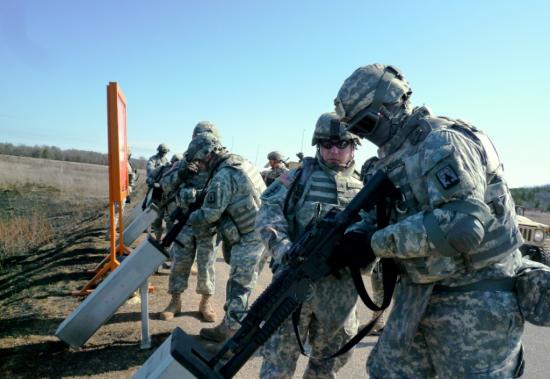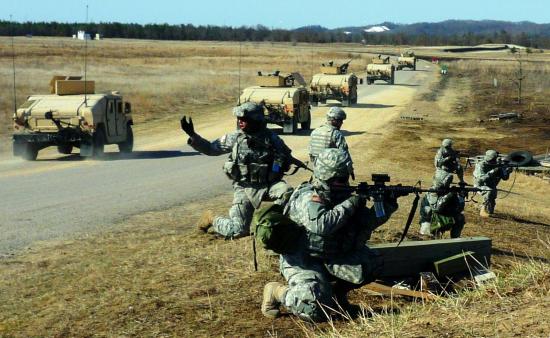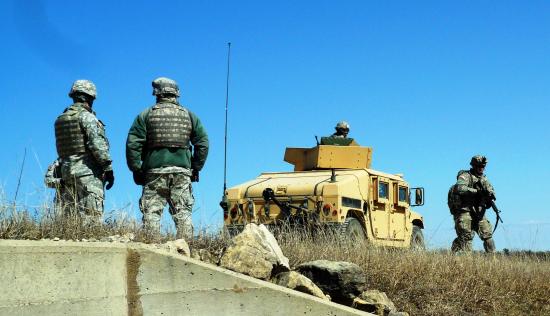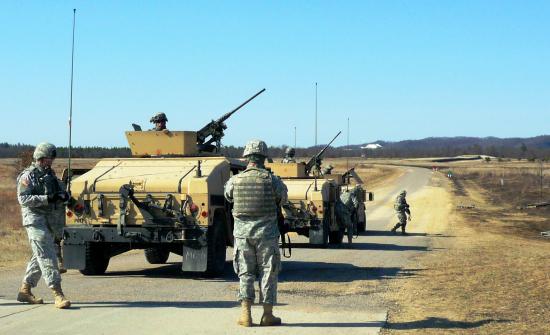 |
Soldiers of the 827th Engineer Company, New York Army National Guard, clear weapons while training at Fort McCoy, Wisconsin. |
827th Engineer Company Training at Fort McCoy
Jump to:
Browse All JournalsLive Fire Operations at Fort McCoy
By Master Sergeant Jerome M. DeBarge
The 181st Infantry Brigade at Ft. McCoy, WI, has been assigned by First Army Division West to train Engineer units deploying to Iraq and Afghanistan. The 3/335th Training Support Battalion (TSBN), Detachment 2 Team is assigned to the convoy operations day and night live fire gunnery training at Range 29.
The Training Mentors (TM) from the 3/335th function by observing, training, mentoring, and assisting mobilizing units in all aspects of their preparation for deployment in support of Overseas Contingency Operations. TM’s train and evaluate in unit troop leading procedures, pre-combat checks (PCC)/pre-combat inspections (PCI), military decision making process, and risk management. TM’s also assists units in developing and implementing a battle focused physical training program; conduct after action reviews (AAR), assesses unit leadership and training progress to ensure mission ready units are properly trained prior to deployment.
To prepare for the unit’s execution of training skills for the live fire exercise, the units conduct PCIs, PCCs, rehearsals, and drills prior to unit execution. Platoon leaders submit training timelines and composite risk management assessments (CMA) for all key events to company and battalion headquarters before training is conducted.
The range uniform consists of complete individual body armor, camel back/water canteens, helmet, ballistic eye protection, gloves, hearing protection with no exception to Army standards.
All training units review and follow set rules of engagement. During the training it is very important Soldiers learn to not engage targets who could be civilians on the battlefield or humanitarian vehicles like ambulances. During the training exercise positive identification (PID) of targets, to avoid collateral damage, is essential for mission success.
The mission is to conduct platoon-sized mounted combat patrol (MCP) operations. Execution begins when 4-8 vehicles maneuver to deny or minimize the enemy’s ability to attack our MCP. The end-state for this operation is when the convoy commander receives a "change mission" over the net from the control tower, known in the exercise as Avenger Base. The typical mission length is 1 hour and broken into 3 phases. The units will conduct the mission once with blank ammunition and once with live ammunition with AAR’s conducted after each.
Phase I begins upon receipt of this order. Unit’s task organize into patrols of 4 vehicles, each with 5 Soldiers per vehicle. Units move tactically to Contingency Operating Location (COL) Sabre, arriving no later than (NLT) 9:00 am on the day of the training mission. Patrol commanders / patrol leaders (PCs/PLs) link up with the TM’s, Officer in charge (OIC) or Non-commissioned Officer in charge (NCOIC) and turn in daily deliverables, such as CRM’s and situation reports (SITREPs), NLT 09:15 am. Phase I ends when the training unit has occupied the COL and completed link up with the TM OIC or NCOIC.
Phase II is the execution phase of the operation and begins with the training unit receiving a safety and range orientation brief from TM’s. Training unit leadership (PL’s and TM’s) will then receive an intelligence brief while the remainder of the unit continues preparation for mission. Upon release from an intelligence brief, the training units conduct final PCI’s, patrol & safety briefings and conduct rehearsals prior to first patrol’s start point (SP) at approximately 10:30 am. Upon receiving orders from Avenger Base the patrol proceeds along alternate supply route (ASR) Blue and ASR Mako. Upon arrival they linkup with elements from the 1-67th Combat Aviation Brigade, the training unit transfers all cargo, and returns to COL Sabre. The remaining patrols continue to prepare for the mission by conducting battle drills and rehearsals as only one patrol is able to be on mission at a time.
Phase III is the recovery phase of the operation and begins with the cleaning the common areas of the range, brass/ammunition pickup detail and refuel vehicles. After those details are complete and confirmed by the TM OIC or NCOIC, the training unit is released to its unit leadership.
At the end of the training, The TM’s get together and do an AAR about the unit that has been trained that day with the senior TM, NCOIC and OIC of the range. Based on the general consensus it is determined if the unit successfully achieved its tasks and if is ready be deployed.





